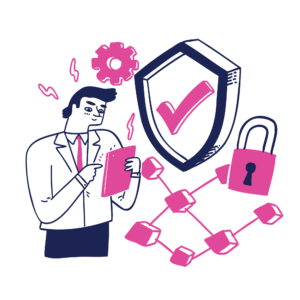
The Power of Digital Rating: Showcase Your Digital Worth
Explore the best practices for achieving digital worthiness in the hospitality industry in 2024.
In the rapidly evolving digital landscape, where customer experiences are the currency of success, the concept of Digital Worthiness has emerged as a defining metric. It’s the measure of your digital realm’s ability to not only meet but exceed the expectations of your audience. And at the heart of this transformation lies accessibility.
We find ourselves at the intersection of innovation, technology, and inclusivity. Customer experience isn’t a single touchpoint; it’s a multifaceted journey that encompasses every interaction, every click, and every moment a user spends with your brand. To truly redefine it, we must recognize that Web Accessibility is not a checkbox; it’s the gateway to inclusivity. It’s about ensuring that every visitor, regardless of their abilities, can engage seamlessly with your digital presence.
And now, enter WCAG 2.2, the latest standard that sets the stage for digital excellence. It’s more than just guidelines; it’s a catalyst for innovation. The cutting-edge impacts of WCAG 2.2 are not just about compliance; they are about pushing the boundaries of what’s possible.
Join us as we explore the profound impact of WCAG 2.2’s cutting-edge impacts, and how they are poised to reshape the landscape of your Digital Worthiness rating.

The Evolution of Web Development : The Power of Accessibility
Understanding WCAG 2.2: Navigating the New Horizon
Crafting Inclusive Websites: Bridging the Digital Divide
Imagine a world without the internet, where communication and information sharing happened through traditional means. But here’s the undeniable truth – the internet is not just growing; it’s exploding. Every day, more devices connect to it, and the types of devices continue to evolve.
Why? Because the internet has created a global marketplace where services and products are accessible to users all over the world. But that’s just the beginning. With the advent of web applications and the Internet of Things (IoT), we’re entering an era where our interaction with the internet is becoming uniquely immersive and vastly improved.
But hold on, there’s more to this story. Once upon a time, web development was synonymous with creating simple web pages and basic websites, whether for intranet or internet. Fast forward to today, web development has transformed into something truly remarkable. It’s about crafting web applications that not only match but often surpass the complexity and scale of traditional mobile and desktop applications.
In fact, web application development can be seen as an art form. It’s the creative process of building sophisticated business solutions that cater to both businesses (B2B) and customers (B2C). It’s about harnessing the full potential of the internet to create digital experiences that leave a lasting impact.
This evolution in web development is akin to the shift from sending letters to using instant messaging apps on our smartphones. We’ve moved from static web pages to dynamic, powerful web applications. And here’s the exciting part: this transformation is far from over. As we explore the crucial role of web accessibility in this ever-changing technological journey, you’ll see that we’re just scratching the surface of what’s possible.
Where web development continues to evolve at a rapid pace, there’s a beacon of guidance that ensures no one gets left behind. It’s the Web Content Accessibility Guidelines (WCAG) 2.2, your compass for creating digital spaces that are inclusive, user-friendly, and technologically advanced.
But what’s new in WCAG 2.2, and why should it matter to you? Well, imagine this: WCAG 2.2 is building on the strong foundation laid by its predecessor, WCAG 2.1. It’s like taking a solid structure and adding extra layers of excellence. It provides additional criteria that specifically target the accessibility of content for use-cases that were a focus of WCAG 2.1.
Now, let’s talk about the specifics. WCAG 2.2 brings substantial improvements in support for various user groups. Imagine the joy it brings to users of small or touch-screen devices. Your website will become a place where they can navigate seamlessly, making their interactions smooth and enjoyable.
And let’s not forget the impact on low-vision users. WCAG 2.2 ensures that your content is not just accessible but also optimized for those with low vision. It’s like providing a well-lit path in a digital landscape, where every word and image is clear and easy to see.
But that’s not all. WCAG 2.2 extends its embrace to users with cognitive, language, and learning impairments. It’s like offering a helping hand to those who might face challenges in understanding complex content. Your website becomes a place where information is presented in a way that suits their needs, making it a valuable resource for everyone.
As we continue our journey through the world of web accessibility, you’ll discover that WCAG 2.2 isn’t just an update; it’s a leap forward in creating a digital space that truly welcomes everyone. It’s your ticket to staying at the forefront of digital innovation, ensuring that your website thrives in the ever-evolving digital landscape. So, let’s dive deeper into the treasures hidden within WCAG 2.2, where every update brings you closer to digital excellence.
Web accessibility isn’t merely a checkbox on your development to-do list; it’s the bridge that connects people of all abilities to your digital world. It’s like building a bridge across a river, ensuring that everyone can cross over to experience what your website has to offer.
But why should you care about crafting inclusive websites? Because it’s not just about compliance; it’s about compassion and empathy. It’s about acknowledging that every visitor to your website deserves the same opportunity to access your content and services, regardless of their abilities.
Think about the user with a visual impairment who relies on screen readers to navigate the web. For them, your website isn’t just a digital space; it’s a lifeline to information, services, and opportunities. Crafting inclusive websites means ensuring that this lifeline remains unbroken.
And let’s not forget the user with a cognitive or learning impairment. For them, your website isn’t just a source of information; it’s a place to learn, grow, and connect. Crafting inclusive websites means presenting content in a way that accommodates diverse learning styles and needs.
As we journey deeper into the realm of web accessibility, you’ll discover that it’s not just a responsibility; it’s a privilege. It’s an opportunity to shape the digital landscape, to break down barriers, and to create digital experiences that leave a lasting, positive impression. So, let’s continue on this path of inclusivity, where every action brings us closer to bridging the digital divide and crafting websites that truly welcome all.
Your website is more than just a digital space; it’s a testament to your digital worthiness. What is digital worthiness, you might ask? It’s the state of offering a digitally-enabled customer experience worthy of praise.
Today’s customers aren’t merely interested in the quality of a brand’s products and services; they demand more. They seek experiences that transcend the ordinary, experiences that are digitally-enhanced and extraordinary. They’re willing to pay not just for good quality but for an exceptional, digitally-enabled customer experience.
This is where digital worthiness steps into the spotlight. Brands recognize that digital excellence is the key to winning the hearts and minds of their customers. They understand that in an era where digital interactions are the norm, showcasing their digital worthiness is essential.
But how does web accessibility fit into this narrative of digital worthiness? The connection is profound. When your website embraces accessibility, it’s a declaration to your customers that you value their experience, regardless of their abilities. It shows that you’re committed to providing a digitally-enabled customer experience that is truly inclusive and exceptional.
The impact on your digital worthiness is remarkable. As your website becomes more accessible, it becomes a showcase of excellence, where visitors applaud your efforts to create a digital space where everyone feels valued and welcomed.
AT Worthy, via its self answered questionnaire, strongly sheds light on the imperative role of WCAG by including it as a high-coefficient question that would directly impact the overall digital rating of any sort of property.
Digital worthiness is your defining chapter. It’s your opportunity to stand out, to elevate your reputation in the digital realm, and to earn the praise and loyalty of your customers. As we journey deeper into the world of web accessibility, you’ll discover that it’s not just a technical requirement; it’s a strategic move that enhances your digital worthiness, creating a digital presence that sets you apart as a leader in the digital era. So, let’s continue this journey of trust, reputation, and digital worthiness, crafting websites that become beacons of excellence in the digital realm.
Embracing accessibility isn’t just a choice; it’s a strategic decision that can define your digital journey. It’s like setting sail towards uncharted territories, and your roadmap to digital excellence begins here.
To truly understand the significance of implementing accessibility, let’s dive into what it means to be compliant with Web Content Accessibility Guidelines (WCAG) 2.2:
Now, let’s delve into the significance of the new recommendations dated October 5th, 2023, in the context of your journey towards accessibility:
In summary, the journey of Web Accessibility Standards entails meeting specific success criteria, conducting thorough testing and evaluation, maintaining meticulous documentation, and a commitment to continuous improvement. The new recommendations dated October 5th, 2023, underscore the importance of embracing these guidelines as a pivotal step toward creating a more inclusive digital environment. As we navigate the seas of accessibility, remember that each step brings us closer to a digital realm where everyone is welcomed, valued, and empowered.
You’ve explored the transformative power of Accessibility and the profound impact it has on both users and businesses. Now, let’s dive deeper into the role Web Accessibility plays in the evolving landscape of customer experience and its direct influence on the digital Worthiness rating.
Customer experience is no longer just a transaction; it’s a profound journey. Today’s customers seek more than just quality products; they aspire to engage with businesses that offer a digitally-enabled customer experience worthy of praise.
This is where accessibility, especially in the light of WCAG 2.2’s new updates, takes center stage. It’s the bridge that connects your brand with your customers, ensuring that every interaction, every digital touchpoint is inclusive, meaningful, and user-friendly.
Consider the digital Worthiness rating as the metric that reflects how well your business performs in the digital realm. The new updates in WCAG 2.2 are like a compass that guides you toward enhancing this rating.
As you embrace accessibility and adhere to WCAG 2.2’s new standards, your digital assets become more inclusive, more engaging, and more appealing to a broader audience. This, in turn, positively impacts your digital Worthiness rating.
Now, as a web developer, content creator, or digital entrepreneur, you are a pivotal player in this unfolding narrative. You possess the knowledge and tools to create digital spaces that not only meet but exceed customer expectations.
Become a champion for Web Accessibility Standards, both in your own projects and as an advocate within your industry. By doing so, you’re not just enhancing customer experience; you’re elevating the digital Worthiness rating of your business.
In closing, remember that Web Accessibility Standards is not just a technical requirement; it’s the key to creating a customer experience that’s truly exceptional. It’s your opportunity to lead the way in shaping a brighter, more inclusive digital future where every user is valued, and every interaction is a testament to your commitment to excellence.
So, let’s embark on this journey together, where Accessibility becomes the hallmark of customer experience, and digital Worthiness rating reflects the transformative impact of your inclusive digital creations. A future of inclusivity, innovation, and customer-centric excellence awaits, and you have a vital role to play in making it a reality.
News

Explore the best practices for achieving digital worthiness in the hospitality industry in 2024.

AT Worthy Technology, Inc. Appoints Terence Ronson as Strategic Advisor to Bolster Digital Initiatives

Explore the best practices for achieving digital worthiness in the hospitality industry in 2024.
Interested in vaunting
Your customers use digital every day to choose where to go,
what to buy, and with whom to engage.
AT Worthy is a sponsor of the UNICODE as a Lifelong and Unique Gold Adopter of the character « @ » the Digital Worthiness’s symbol.
AT Worthy is officially listed in the Directory of Standard Developer Organization of the ANSI – American National Standards Institute.
© 2024 AT Worthy Technology. All Rights Reserved.